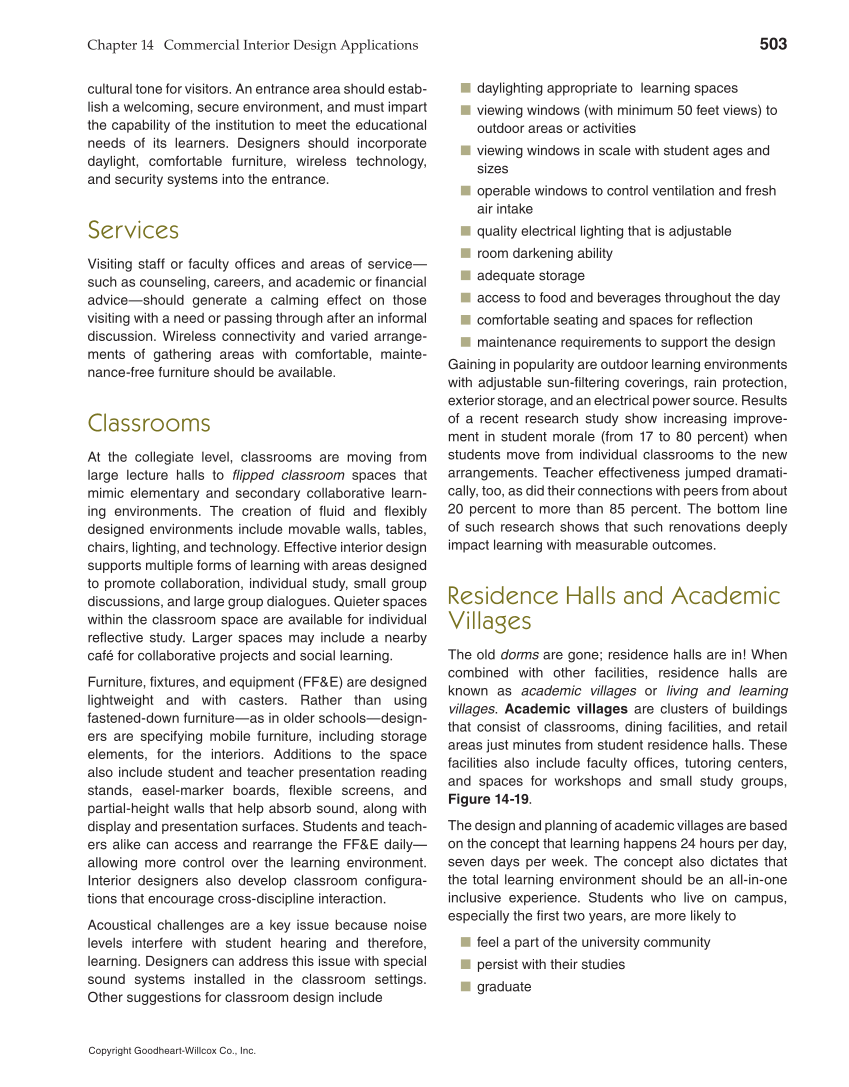Chapter 14 Commercial Interior Design Applications 503 Copyright Goodheart-Willcox Co., Inc. cultural tone for visitors. An entrance area should estab- lish a welcoming, secure environment, and must impart the capability of the institution to meet the educational needs of its learners. Designers should incorporate daylight, comfortable furniture, wireless technology, and security systems into the entrance. Services Visiting staff or faculty offi ces and areas of service— such as counseling, careers, and academic or fi nancial advice—should generate a calming effect on those visiting with a need or passing through after an informal discussion. Wireless connectivity and varied arrange- ments of gathering areas with comfortable, mainte- nance-free furniture should be available. Classrooms At the collegiate level, classrooms are moving from large lecture halls to fl ipped classroom spaces that mimic elementary and secondary collaborative learn- ing environments. The creation of fl uid and fl exibly designed environments include movable walls, tables, chairs, lighting, and technology. Effective interior design supports multiple forms of learning with areas designed to promote collaboration, individual study, small group discussions, and large group dialogues. Quieter spaces within the classroom space are available for individual refl ective study. Larger spaces may include a nearby café for collaborative projects and social learning. Furniture, fi xtures, and equipment (FF&E) are designed lightweight and with casters. Rather than using fastened-down furniture—as in older schools—design- ers are specifying mobile furniture, including storage elements, for the interiors. Additions to the space also include student and teacher presentation reading stands, easel-marker boards, fl exible screens, and partial-height walls that help absorb sound, along with display and presentation surfaces. Students and teach- ers alike can access and rearrange the FF&E daily— allowing more control over the learning environment. Interior designers also develop classroom confi gura- tions that encourage cross-discipline interaction. Acoustical challenges are a key issue because noise levels interfere with student hearing and therefore, learning. Designers can address this issue with special sound systems installed in the classroom settings. Other suggestions for classroom design include ■ daylighting appropriate to learning spaces ■ viewing windows (with minimum 50 feet views) to outdoor areas or activities ■ viewing windows in scale with student ages and sizes ■ operable windows to control ventilation and fresh air intake ■ quality electrical lighting that is adjustable ■ room darkening ability ■ adequate storage ■ access to food and beverages throughout the day ■ comfortable seating and spaces for refl ection ■ maintenance requirements to support the design Gaining in popularity are outdoor learning environments with adjustable sun-fi ltering coverings, rain protection, exterior storage, and an electrical power source. Results of a recent research study show increasing improve- ment in student morale (from 17 to 80 percent) when students move from individual classrooms to the new arrangements. Teacher effectiveness jumped dramati- cally, too, as did their connections with peers from about 20 percent to more than 85 percent. The bottom line of such research shows that such renovations deeply impact learning with measurable outcomes. Residence Halls and Academic Villages The old dorms are gone residence halls are in! When combined with other facilities, residence halls are known as academic villages or living and learning villages. Academic villages are clusters of buildings that consist of classrooms, dining facilities, and retail areas just minutes from student residence halls. These facilities also include faculty offi ces, tutoring centers, and spaces for workshops and small study groups, Figure 14-19. The design and planning of academic villages are based on the concept that learning happens 24 hours per day, seven days per week. The concept also dictates that the total learning environment should be an all-in-one inclusive experience. Students who live on campus, especially the fi rst two years, are more likely to ■ feel a part of the university community ■ persist with their studies ■ graduate
